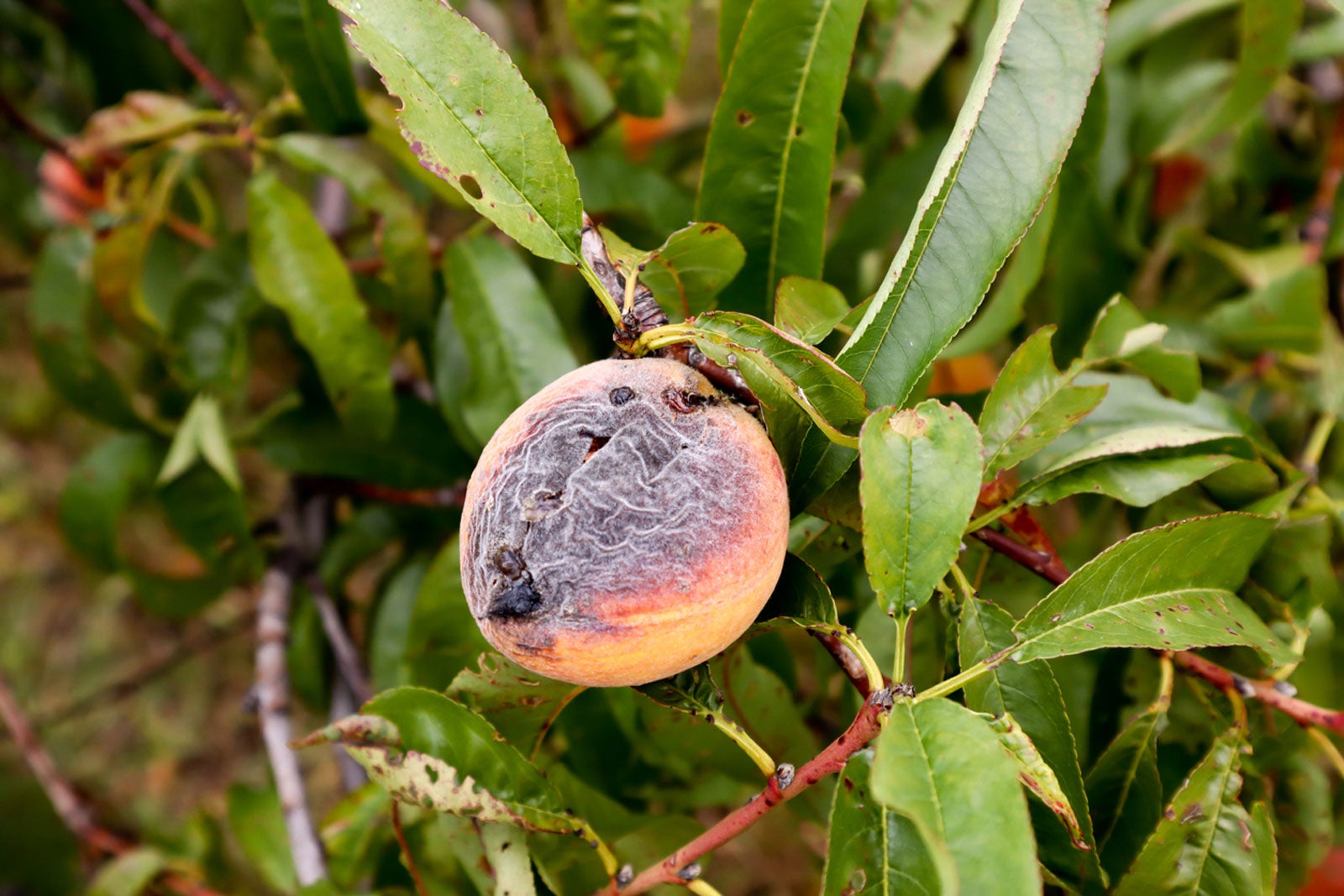Common Peach Diseases: Peach Tree Care For Sick Trees


Grow a peach tree in your yard and you’ll never go back to store-bought. The rewards are great, but peach tree care calls for some careful attention so they don’t fall prey to some of the common peach diseases. It’s important to learn common peach disease symptoms so you can get a jump on managing them and avoid these issues in the future.
Is My Peach Tree Sick?
It’s important to watch for peach disease symptoms so you can treat your tree as quickly as possible. Peach tree diseases and fungus are common problems and can affect nearly any part of the tree. If your tree seems to be ailing or your fruit doesn’t look right, read on.
Common Peach Diseases
Here’s a quick rundown of some of the most common types of peach tree diseases: Bacterial Spot – Bacterial spot attacks both fruits and leaves. It produces purple-red spots with white centers on leaf surfaces that may fall away, leaving a shot-hole appearance in the leaf. Bacterial spot on the fruit starts with small dark spots on the skin, gradually spreading and sinking more deeply into the flesh. Fortunately, damage on fruits can be cut out and the fruit still eaten, even if they don’t look good enough for the produce market. Good cultural care is critical for preventing bacterial spot. A few partially resistant peach varieties are available, including Candor, Norman, Winblo, and Southern Pearl. Brown Rot – Brown rot is arguably the most serious disease of peach fruits. Brown rot fungus can destroy flower blossoms and shoots, beginning at bloom time. You can recognize it by the small, gummy cankers that appear on infected tissues. It will spread to your healthy green fruits when the wet weather sets in. Infected fruit develop a small, brown spot that expands and eventually covers the whole fruit. The fruit will ultimately shrivel and dry up, or “mummify,” on the tree. You’ll need to remove and burn all mummies from the tree to break the brown rot life cycle. Consult with your local garden center, an agricultural extension agent, or a certified arborist about applying a fungicide to ward off the fungus for the next harvest. Peach Leaf Curl – Peach leaf curl can appear in the spring. You may see thick, puckered, or distorted leaves with a red-purple cast begin to develop instead of your normal, healthy leaves. Eventually, leaves affected by leaf curl will grow a mat of gray spores, dry out, and drop, weakening the tree itself. Once this first round of leaves has dropped, however, you probably won’t see much of this condition for the rest of the season. A single spray of lime, sulfur, or copper fungicide all over the tree each winter should prevent future problems with peach leaf curl. Peach Scab – Peach scab, like bacterial spot, is for the most part just an aesthetic problem. Small, dark spots and cracks appear on the surface, but may be so numerous they grow together into large patches. Shoots and twigs might develop oval lesions with brown centers and raised purple margins. It’s important to increase the air circulation in the tree’s canopy by pruning it, severely if necessary. After the petals fall, you can spray with a protectant fungicide, like wettable sulfur. Treat the tree with spray five times, at 7 to 14 day intervals after the petals have fallen. Peach Yellows – Peach yellows is a common problem in trees that aren’t already on a spray program and is transported by leafhoppers. Leaves and shoots may emerge in a deformed manner creating clusters, or witches brooms. Fruits from trees suffering from peach yellows will ripen prematurely, and are likely to be bitter and of poor quality. Peach yellows may only affect part of the tree, however, there is no cure for this problem – once the symptoms are obvious, removing the tree is the only option. Peach trees can be vulnerable but, with good, attentive peach tree care, you’ll have perfect peaches and healthy trees.
Gardening tips, videos, info and more delivered right to your inbox!
Sign up for the Gardening Know How newsletter today and receive a free copy of our e-book "How to Grow Delicious Tomatoes".

Caroline Bloomfield is Manager of Marketing Communications at Gardening Know How since 2019. A northwest native, she has resided and gardened in multiple zones in the U.S. and is currently at home in Bandon, Oregon. Writing and editing for various publications since 1998, her BA in American Studies from Southern Maine University includes an emphasis in English. She was raised in California by avid gardeners and continues to enjoy the natural world with an appreciation for the concepts of sustainability and organic care for the planet.
-
 Try The Trend – Turn Any Bed Into A Keyhole Garden With This Clever In-Ground Composter
Try The Trend – Turn Any Bed Into A Keyhole Garden With This Clever In-Ground ComposterKeyhole gardening is an efficient and sustainable practice that saves space. Get started on this DIY project quickly and easily with an in-ground composter.
By Bonnie L. Grant
-
 4 Superfast Composting Methods: Turn Waste Into Garden Gold In 30 Days Or Less
4 Superfast Composting Methods: Turn Waste Into Garden Gold In 30 Days Or LessTry the fastest composting methods to turbocharge your pile and transform kitchen scraps and garden waste into finished compost in just a few weeks.
By Mary Ellen Ellis